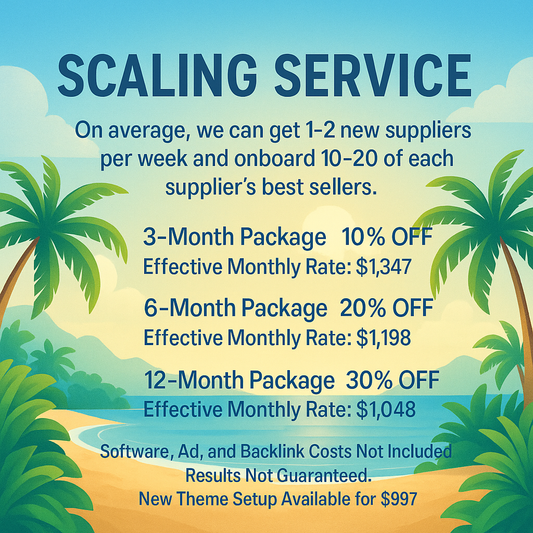
Crafting a Mobile-Friendly Ecommerce Experience
Hey there, friends! Trevor Fenner here, the founder of Ecommerce Paradise. If there’s one thing I’ve learned in my journey through the eCommerce world, it’s that optimizing your online store for mobile is no longer just an option—it’s a necessity. In an age where smartphones are practically an extension of ourselves, ensuring your eCommerce website provides a seamless mobile experience can be the driving force behind your business success. Let’s dive into the essentials of building a mobile-friendly ecommerce experience that not only enhances user satisfaction but also boosts your SEO efforts, driving traffic and sales in the process.
The Mobile Shift: Understanding Its Importance
Did you know that over half of all internet traffic comes from mobile devices? This statistic should be a wake-up call for all eCommerce businesses. In recent years, the proportion of consumers shopping via mobile has skyrocketed. If your online store isn’t mobile-optimized, you might be missing out on a significant chunk of potential sales.
The Impact on User Experience
A mobile-friendly site creates a better user experience, which translates into higher engagement rates and most importantly, increased sales. If your page takes too long to load or is difficult to navigate on a smartphone, potential buyers will quickly lose interest and leave. With this in mind, let’s explore how to design a mobile-friendly eCommerce experience that resonates with users.
Key Elements of a Mobile-Friendly Ecommerce Experience
1. Simplified Navigation
One of the most critical aspects of a mobile-friendly design is simplified navigation. Make sure your website’s menu is easily accessible and that customers can find their desired products quickly. Use concise category labels and consider incorporating a search bar for ease of access. A clutter-free layout allows users to focus on what they came for—shopping!
2. Fast Load Times
Studies show that 53% of mobile users abandon sites that take longer than three seconds to load. To keep potential customers engaged, optimizing your website’s speed is crucial. Here are a few tips to enhance your load times:
- Compress images without sacrificing quality.
- Minimize HTTP requests by combining CSS and JavaScript files.
- Use browser caching to store frequently accessed data locally.
3. Responsive Design
Responsive design is a cornerstone of a mobile-friendly eCommerce site. Simply put, it means your website automatically adjusts to the size of the screen it’s being viewed on. This adaptability ensures customers have a consistent and enjoyable shopping experience, no matter what device they’re using.
4. Optimize for Thumbs
Another critical aspect is touch optimization; mobile users navigate primarily with their thumbs. Make sure buttons are large enough for easy tapping, and space elements apart so that users don’t accidentally click the wrong link. A well-designed site encourages interaction without frustration.
5. Quality Images and Content
Quality visuals can make or break the online shopping experience. Use high-resolution images that load quickly to showcase your products effectively. Text should be concise and legible—avoid large paragraphs, and instead, opt for bullet points or short descriptions summarizing the key features.
Boosting Your SEO with Mobile Optimization
Optimizing your eCommerce store for mobile not only enhances user experience but also significantly impacts your SEO strategy. Search engines like Google prioritize mobile-friendly websites in their rankings, especially with the growing number of searches conducted on mobile devices. Here’s how you can leverage mobile optimization to boost your Ecommerce SEO:
Mobile-First Indexing
Google uses what's called mobile-first indexing, which means it primarily looks at the mobile version of your website for ranking purposes. Make sure that the mobile version of your site has all the same content as its desktop counterpart. Be proactive by monitoring how your site appears on mobile—this means checking for broken links, easy-to-read fonts, and more.
Utilize Google Shopping Ads
If you haven’t yet ventured into the realm of Google Shopping Ads, now is the time! These ads can significantly amplify your reach, especially when optimized for mobile searching. The visually engaging format of Shopping Ads catches the attention of potential buyers and caters to their impulse purchasing habits right at their fingertips.
Schema Markup
Implementing schema markup can enhance your website’s search visibility. Schema provides search engines with explicit information about your products, improving your chances of appearing in rich snippets. This is especially vital for mobile searches where visual content is paramount; it helps your listings stand out amongst the competition.
Email Marketing and Its Compatibility with Mobile
While we’re on the topic of driving traffic, let’s chat about Email Marketing. This powerful tool can yield a high return on investment if used effectively, especially when tailored for mobile users.
Mobile-Friendly Email Campaigns
With a significant segment of emails being opened on mobile devices, it’s crucial to ensure your email designs are mobile-responsive. Here are a few best practices:
- Keep your subject lines short and enticing.
- Utilize a single-column layout for easy reading on small screens.
- Incorporate clear CTAs to guide mobile users seamlessly to your website.
Dropshipping and Mobile Experience
If you’re in the dropshipping business, making your mobile experience stellar can give you a competitive edge. Customers tend to appreciate the convenience dropshipping provides. Therefore, optimizing shopping channels is essential. The easier you make it for them to browse and purchase from their phones, the more likely they’ll complete that sale!
Streamlined Checkout Process
Mobile users often prefer quick and efficient transactions. A seamless and simple checkout process is critical for capturing sales. Here are tips for an effective checkout experience:
- Minimize the number of form fields to avoid overwhelming users.
- Offer multiple payment options suitable for mobile customers, like digital wallets.
- Consider incorporating a guest checkout option to eliminate additional steps.
Tracking and Analytics for Continuous Improvement
One of the best things about running an online store is that you can gather data continuously. Use this information to improve your mobile experience over time. Implement tracking and analytics tools to monitor how users interact with your site on mobile devices. Track metrics like bounce rates, conversion rates, and cart abandonment to identify areas for improvement.
Heatmaps and User Feedback
Utilizing heatmaps can provide insights into user behavior on your mobile site. By seeing where users spend the most time or which elements they ignore, you can make informed adjustments. Additionally, gather feedback directly from customers—after all, they are the ones using your site!
The Final Word: Elevating Your Ecommerce Game
Building a mobile-friendly ecommerce experience is more than just checking boxes; it’s about creating a shopping environment that caters to modern consumers’ needs. With a thoughtful layout, responsive design, and optimized content, you’ll be setting your eCommerce business up for long-term success. Remember, a satisfied mobile customer is more likely to return, share their experience, and convert into a loyal buyer. Here’s to crafting an incredible shopping journey that elevates your business to new heights!


















